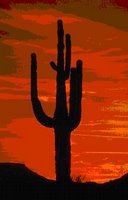Saguaro -- the cactus that almost looks human
 The saguaro is one of the most distinctive of all the catci, easily recognized the world over, yet its geographical range is limited to the Sonoran desert which runs from southern Arizona into Mexico.
The saguaro is one of the most distinctive of all the catci, easily recognized the world over, yet its geographical range is limited to the Sonoran desert which runs from southern Arizona into Mexico.This specie of cactus, Carnegiea gigantea, grows extremely slowly. It starts out as a single column and does not even produce flowers until it's about 35 years old. Then it's another 15-35 years before the characteristic arms begin to grow. The plant is not considered mature until it has lived about 125 years, and it can be expected to live another 25-50 years past that to the ripe old age of 150-175. Some plants have lived up to 200 years.
The saguaro has a radial root system which is extremely effective at taking up water during heavy rains, where it is stored in the body of the cactus. In fact, the majority of the plant is water. This means that an adult saguaro, measuring upwards to 50 feet in height, can weigh 6 tons or more!
The strange case of David Grundman (not an urban legend) proves that saguaros should be left alone. In 1982 Grundman and his roommate were out shooting saguaros in the Arizona desert. Grundman shot a small one and hit it enough times that it toppled over. He then turned his attention to a 100 year old specimen that stood a proud 26 feet tall. He severed one of the arms -- not even the entire cactus -- and the weight of the falling arm crushed him to death.
Left alone, the saguaro is a beneficial plant, providing housing for woodpeckers, owls, hawks and other birds; nectar for insects, birds and bats; and fruit for coyotes, birds and humans. Archeological evidence indicates that the ribs of the cactus were used to construct framework for the homes of ancient indigenous people.
The biggest theat to the saguaro is the loss of habitat due to human population growth. The introduction of non-native plants is a further threat, as the exotic plants require more water than their native counterparts and actually lead to an increase in wildfires.
Reference: National Park Service, Urban Legends Reference Pages


0 Comments:
Post a Comment
<< Home